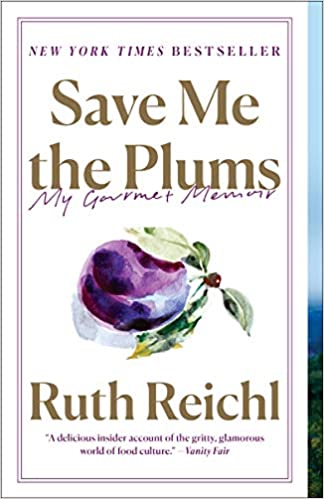Save Me the Plums: My Gourmet Memoir is an inspiring story of a risk
Eat the Plums, Take the Risk By Ruth Reichl

My Gourmet Memoir is an inspiring story of a risk Ruth Reichl took head on, changing the face of Gourmet, and her, forever.
The stories our parents tell us growing up often have a lasting impact on our lives. For some, the stories of trips they’ve taken around the world inspire them to want to do their own traveling, but my stories were quite unique.
In the heyday of fashion magazines, my mom worked as an editor of Glamour magazine in the iconic Times Square Condé Nast headquarters building.
Her stories about her Condé Nast days were always my favorite.
She’d recount lunchtime stories in the fabled Condé Nast cafeteria where garlic was banned, solely because Si Newhouse didn’t like it. You never knew who you were gonna see there. Celebrities and the editors-in-chiefs, who were practically celebrities themselves at the time, could walk in at any given moment. There were new specials everyday, but the Vogue interns always stuck to lettuce.
I’d also get elevator tales of models riding up with casting directors for go-sees and protocol for rides with Anna Wintour. (Note to self: If you ever find yourself in the situation where you’re riding in the elevator with Anna Wintour, do not make eye contact with her and do not speak.)
There were the stories of the whirlwind weekend where she’d come home to her and my dad’s Upper East Side shoebox apartment to pack for a spontaneous weekend trip to St. Maarten for a Dove product launch.
But my favorite stories were the random days where my dad would get a call from my mom while at work.
She’d say, “Be ready in 15, I’m on my way with my boss. Mustafa’s driving.”
Next thing they know they’re eating dinner at one of the cool, new downtown restaurants that typically takes weeks to get a reservation at.
This was just how life worked at Condé Nast. It was hard work, but Mustafa was always there to drive you at the end of the day.
And that’s exactly what Ruth Reichl learned throughout her time as editor-in-chief at Gourmet.
In her memoir Save Me the Plums: My Gourmet Memoir, she covers the 10 years she worked there, from the moment she was approached by James Truman to the moment Si Newhouse announced the magazine was shutting down. She hits everything: mini restaurant reviews, recipes, life as a working mother, and how she didn’t let the glamour of Condé Nast get to her.
Before turning around Gourmet, Reichl was the restaurant critic at The New York Times and before that the Los Angeles Times. When James Truman first approached her about the position, she said no. He refused to take that for an answer, asking her how she could turn this opportunity down. “Didn’t anyone say no to Condé Nast?” she wrote.
The answer was clearly no; nobody says no to Condé Nast. She recognized that as soon as she left tea with Truman. “It took a full block before I realized that I had just turned down the chance to run the magazine that had inspired all the work I’d ever done” (Reichl 16).
Reichl brought Gourmet back to it’s golden days. She made it appeal to the everyday people, not just the upper class people with a personal chef or the foodies who followed every little French rule.
Reichl’s writing and diction is what made this book so resonating. After reading every chapter, I was starving.
How she describes the food she ate at restaurants around the world inspired me to want to go on a food tour of my own, once the world is out of quarantine, of course. Her use of sensory imagery will make anyone hungry, even if you just ate a full three course meal. “I tore off a hunk of bread and scooped up a slab of pâté. The flavor filled my mouth–strong, rustic, a pâté with conviction” (Reichl 238).
She takes the readers along her journey of learning the world of magazines. Reichl went in as editor-in-chief never having worked at a magazine like Gourmet before, but she didn’t let it deter her from turning the magazine around. We’re given a first hand view as she deciphers what “teeosees” means (table of contents) and how sales calls work (and learned how much she hated them).
Throughout the memoir, some of Reichl’s favorite recipes are incorporated, just as a reminder that her passion for food is not just through words. Her favorite nights, and a main reason for her accepting the position at Gourmet, were when she would come home and cook for her family. As a working mother, being a restaurant critic wasn’t her ideal job. She was constantly missing dinner to eat at a restaurant for a review, so being able to be home for her family was a major benefit of accepting the position at Gourmet. But still, being a working mother was not an easy job. Society’s standards were and are still that the men will work and women will stay home. Even if both parents worked, the mother was still seen as the first person to contact if something happened at daycare or school. “Working men did what was convenient; working women did everything else. And felt constantly guilty: No matter where you were, it always felt like the wrong place” (Reichl 71). If she wasn’t at work, she was with her family, feeling like she should be at work. And if she wasn’t with her family, she was at work, feeling like she should be with her family.
Reichl soon got adjusted to her new life at Condé Nast, but she could never fully comprehend the monetary aspect. The salary with everything included: a car, a driver, a clothing allowance, country clubs, hairdressers, travel, you name it. She never let herself get caught up in the money and glamour of the job. Even though Mustafa drove her to work everyday, it took time for her to fully embrace that she was now a top tier editor at the world’s largest publication company of the time.
This was all reflected in her work. After the 2008 recession hit, magazine sales slowed. When Gourmet decided to do an edition of Paris on a budget, she was the one who went to Paris, on a budget. She delved into the job first-hand, staying at cheap hotels and eating at cheap restaurants. The last time she went to Paris was for a special edition of Gourmet, and she stayed at 5 star hotels and ate at extravagant restaurants, but this Paris on a budget trip reminded her of her younger days when she was just starting to see the world.
“…Luxury is best appreciated in small portions. When it becomes routine it loses its allure” (Reichl 246). This was basically her mindset throughout her time at Gourmet. She understood the glamour of the job, but her main purpose was always to work to produce the best magazine she could. She’d enjoy the small portions of luxury when she earned it.
Reichl’s character shines through her memoir. The way she treats everyone she worked with, from her writers, to Gourmet’s cooks, to Mustafa–it was always with a respect and pride that translated throughout Save Me the Plums.
Taking the jump from restaurant critic to editor-in-chief was not an easy one, but Reichl handled it with grace and determination. “Change is always lurking, waiting to pitchfork you into a new life” (Reichl 30). Save Me the Plums: My Gourmet Memoir is an inspiring story of a risk Ruth Reichl took head on, changing the face of Gourmet, and her, forever.


